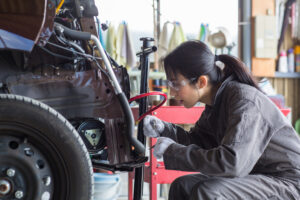
AIA Canada: Collision repair sector is losing talent to other sectors
By onCollision Repair | Education | Market Trends
The Automotive Industries Association of Canada (AIA Canada) released a new labor market research report that sheds light on the collision repair talent shortage.
Its study found that as 65% of mechanical and collision shop owners experienced an increase in technician turnover last year, nearly half of the technicians who quit did so for higher-paying jobs.
Others abandoned the space due to poor perception of the industry, lack of career development opportunities, and better working conditions elsewhere, the report found.
Among the talent that left the industry for better-paying alternatives, 13% moved into the construction space, AIA Canada said. It noted that the average $1,483 weekly income from construction is higher than the approximately $983 earned in auto repair and maintenance per week.
“The skills acquired in auto repair, such as mechanical aptitude, manual dexterity, etc., are transferable to roles in construction, such as equipment and other specialty contractors,” the report said. “The transportation and warehousing industry also attracts workers seeking higher earning potential. For instance, machinery and transportation equipment mechanics (except motor vehicles) is a common destination for auto care workers, offering higher hourly wages compared to automotive service technicians.
“The overlap of required qualifications, such as the completion of mechanical apprenticeship programs, makes transitioning to these industries a viable and attractive option for those seeking a career change.”
Workers ages 18-24 were most likely to leave the automotive industry for other fields. Among those ages 25 -54, more than 25% of those who left their auto-related jobs did so to work for an automotive dealership, AIA Canada said.
Retail trade is another popular destination for workers exiting the automotive repair industry, despite its weekly pay home averaging just $702 per week.
“Although wages in the retail trade industry tend to be lower on average, analysis on a more granular level shows that motor vehicle and parts dealer industry potentially attract workers from the auto care industry with higher compensation,” the report said.
AIA Canada’s research also found that apprenticeship programs within the automotive trades have dropped since 2019, with program completions “experiencing the largest drop in nearly three decades” during the pandemic.
To improve talent and retention within the automotive trade sectors, AIA Canada recommended three courses of action:
-
- Empower tradespeople through updated policies and regulations that could reduce the financial burden for those working in the field;
- Improve collaboration between government, industry, academia, and membership organizations to update training programs and career pathways; and
- Increase awareness of the opportunities available in the field, and improve the perception of working within the space.
Earlier this year, a survey of 1,000 U.S. young adults found that a “significant stigma” continues to surround vocational schools as most parents discourage their children from entering the trade.
Jobber’s recently released Blue Collar Report found that among those surveyed, who were between the ages of 18 and 20, 74% believe there are negative connotations associated with attending a trades school rather than a four-year university.
I-CAR is among the organizations working to right the industry’s perception through its new Collision Careers marketing campaign.
Dara Goroff, I-CAR’s vice president of planning and industry talent programming, previously told Repairer Driven News that there are a number of objectives for the campaign, including ones targeting high school students, such as:
-
- Providing information specifically targeted to job seekers and students that illustrate the benefits and growth opportunities within the industry;
- Sharing information on where to find support resources, such as scholarship opportunities, education, and advice;
- Distributing print and digital brochures for school advisors or guidance counselors so they can guide students to appropriate educational sources for collision repair; and
- Shared advertising that all industry segments can use to amplify the message to the future technician audiences they are closest to.
Jobber’s report said that because the skilled trades have been “devalued as a career option” by the parents of young adults, more work must be done to educate society on the value of such opportunities.
“This career path has traditionally been presented as a Plan B to a four-year degree and underpinned with the perception that earning potential and entrepreneurial opportunities are far more limited than what they are,” Jobber said. “The thinking around pursuing a career built around a trade needs to be shifted at an institutional and parental level.
“To counteract the stigma around trade careers, families should encourage young people to pursue hands-on career paths, our educational systems need to demonstrate the viability of these career paths, and the general public needs to celebrate the contribution of tradespeople and home service companies.”
Meanwhile, the results of a survey by the Society of Collision Repair Specialists (SCRS) and I-CAR show that collision repair technicians are becoming more dissatisfied with their jobs every year.
The survey was available for technicians to take online in July and August. There were 839 respondents. Ducker Carlisle compiled the results and presented some of the highlights during the Collision Industry Conference (CIC)’s meeting on Tuesday in Las Vegas.
Career satisfaction, compensation, and career feedback were the focus areas of the survey. Key topics were experience, workload, compensation, satisfaction, emerging technology, network support, training, and tools.
“If you don’t invest in your shop and in your technicians and their ability to grow [and] learn new skills, what tools are they able to work with? To them, it’s perceived as a lack of investment in themselves,” said Ducker Carlisle Managing Director Meredith Collins. “They’ve invested a lot of time and money and effort to become a technician in the first place and are working really hard for your shops. They don’t feel that same love in return and that same demonstration of feeling [like] a valued member.”
Images
Featured image courtesy of tdub_video/iStock
